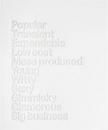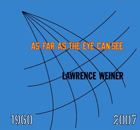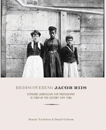Book Digest: March 24, 2008
It is not yet clear to me whether Nicholson Baker’s amazing and brave new book, Human Smoke: The Beginnings of World War II, the End of Civilization, will have a normal cycle of attention or if his treatment of the various belligerents’ bombing of enemy cities and exposé of Allied icons will serve to prolong that attention—and perhaps even result in public discourse that is enlightening and constructive.
Judging by the reviews, it’s too early to tell—except that it appears that reactionary conservative commentators have turned churlish and belligerent and, sadly, rhetorical instead of reasonable. Ed Champion organized a smart gabfest or, as he referred to it, a “roundtable,” to scrutinize the new Baker opus. After multitudinous exchanges by various literary denizens, Baker weighed in with elucidating remarks. Colm Tóibín’s even-handed comments are very conscious of the audience and its reactions, and he concludes:
Nonetheless, the issues Baker wishes to raise, and the stark system he has used to dramatize his point, make his book a serious and conscientious contribution to the debate about pacifism. He has produced an eloquent and passionate assault on the idea that the deliberate targeting of civilians can ever be justified.
Pop Art Is edited by Mark Francis

This book commemorates Richard Hamilton’s defining letter of 50 years ago—in which he wrote, “Pop Art is: popular, transient, expendable, low-cost, mass-produced, young, witty, sexy, gimmicky, glamorous, and Big Business—and presents the works of Hamilton himself, Rauschenberg, Johns, Warhol, Koons, Hirst, and more. Greil Marcus provides a connecting text and Francis, a director of the Gagosian Gallery and formerly of Pittsburgh’s Warhol Museum, assembles a representative 139 illustrations.
The Ghost Soldiers: Poems by James Tate

I can’t name two Pulitzer Prize-winning poets, so I am not sure what it means that University of Massachusetts mentor Tate has won one (and a National Book Award), but at the least it has allowed him to continue to publish. This fair-sized collection contains nearly 100 poems in his by-now-familiar straightforward language and surreal point of view.
Long Life Cool White: Photographs and Essays by Moyra Davey

The Fogg Museum is exhibiting a 40-photograph mid-career retrospective of artist and writer Davey. This catalogue of that exhibit includes an essay, “Notes on Photography and Accident.” I did not previously know of Davey, but the exhibition announcement postcard contained a fascinating image of an animal’s lower leg. That’s how it goes sometimes, right?
» See images from Long Life Cool White
Understanding America: The Anatomy of an Exceptional Nation edited by Peter H. Schuck and James Q. Wilson

This collection of essays about America—which is, as the editors express in the book’s introduction, “the 800-pound elephant in every room in the world”—is a rather ambitious attempt to explain the rampant exceptionalism that is the conceptual backbone of America’s place in the world. More than 30 noted and well-credentialed scholars hash over the well-hashed-over contradictions that bound in the American constellation.
» Read an excerpt from Understanding America
W.H. Auden: Prose, Volume III: 1949-1955 edited by Edward Mendelson

Four Weddings and a Funeraldid more for Auden’s visibility than any of his extensive and well-regarded poetizing. This muscular volume contains a fair chunk of Auden’s prose in the post-war years, including his first separately published book of prose, The Enchafèd Flood: or, The Romantic Iconography of the Sea, and more than 100 essays, reviews, introductions, and lectures—and two unpublished New Yorker reviews.
» Read an excerpt from W.H. Auden: Prose, Volume III: 1949-1955
1948: A History of the First Arab-Israeli War by Benny Morris

Morris is one of Israel’s historical young turks—or “New Historians”—which means he is involved in a revisionist approach to Israeli and Middle-Eastern history: a task made more difficult by the inaccessibility of Arab archives. Morris attempts to provide a comprehensible context as well as spotlight the creation of the Palestinian problem, for the first of the many wars and conflicts that make up 20th-century Arab-Israeli relations.
Lawrence Weiner: As Far as the Eye Can See edited by Donna de Salvo and Ann Goldstein

Conceptual artist Weiner’s first major retrospective at the Museum of Contemporary Art, Los Angeles, and the Whitney Museum of American Art occasioned the creation of this comprehensive exhibition catalogue. What else do you need to know?
Foyle’s Philavery: A Treasury of Unusual Words Christopher Foyle

I happen to be one of those people who love these kinds of books, though unfortunately they frequently get lost in the mélange of frippery that is located around the checkout counter at better bookstores. Anyway, Foyle, who happens to own such a bookstore in London, has collected a fair-sized book’s worth of odd and distinctive words, his favorite of which is “kakistocracy, a system of government where the rulers are the least competent, least qualified or most unprincipled citizens”—a word we ought to use more frequently. Indeed, thanks to this book I love a great deal of new lexicographical acquaintances: gledge, expiscate, prink, stegophily, celsitude, and so forth. My favorite: a charientism.
Where to Invade Next edited by Stephen Elliott

In these seven essays, novelist and political activist Elliot and friends (Jason Roberts, Eric Martin, Andrew Altschul, and a team of 15 college students) imagine the Pentagon war plans memo referred to in a chat between Amy Goodman and Gen. Wesley Clark. All of which should make you think of “kakistocracy.”
Free Lunch: How the Wealthiest Americans Enrich Themselves at Government Expense (and Stick You With the Bill) by David Cay Johnston

The title pretty much tells you what this book is about: a notion familiar to Americans, even those who continue to deny what their eyes and ears are telling them. New York Times tax policy reporter Johnston’s previous book, Perfectly Legal: The Covert Campaign to Rig Our Tax System to Benefit the Super Rich—and Cheat Everybody Else, points out the regulations that turned the federal government into a reverse Robin Hood. No surprise, except for the brazen, shameless, in-broad-daylight way this comes about.
» Read an excerpt from Free Lunch
Shakespeare’s Wife by Germaine Greer

Given the ocean-going barge full of verbiage and scholarship devoted to the Bard, it is at least refreshing and possibly instructive that ‘70s feminist hellion Greer should correct the previously skimpy and apparently mistaken record on Anne Hathaway, William Shakespeare’s wife. Positing the theory that the farmer’s daughter Hathaway was a remarkable woman, Greer advances our understanding of Shakespeare with a clear and seemingly more accurate picture of Will and Anne’s domestic situation.
» Read an excerpt from Shakespeare’s Wife
Old War: Poems by Alan Shapiro

For what it’s worth, poet Shapiro has been a happy man since he survived a health scare a few years ago and remarried. Thus his ninth and latest collection of poems, while filled with complex and competing emotions, is not weighed down with excessive doom and gloom—though not marred by too much cheer. He sets us against a mean and volatile world through monologues and song-like poems.
» Read an excerpt from Old War
Rediscovering Jacob Riis: The Reformer, His Journalism, and His Photographs by Bonnie Yochelson and Daniel Czitrom

Even basic American history survey courses make mention of and credit muckraking photographer Riis for being the first to publicize and expose the harrowing lives of the East Coast urban poor. Yochelson and Czitrom apparently revise the accepted wisdom and rehabilitate Riis’s reputation from its racist and opportunist taint. However you choose to value Riis and his place in U.S. social history, this well-illustrated discussion warrants attention.
Hollywood Crows by Joseph Wambaugh

After a decade-long vacation from fiction, Wambaugh returned a few years ago with Hollywood Station, a pastiche of police stories unified by the organizational point of origin of those tales. This newest opus centers on community relations officers—”CROWS”—and the stranger-than-reality characters, dialogue, and events that comprise police life in this cauldron of the American dream machine. Of course, Wambaugh knows a good story when he hears one, and he’s been collecting them for years by having dinners with small groups of police and letting them do the talking—he credits 55 of those cops in this book’s acknowledgements. Add Wambaugh to the pantheon of superior crime-story writers like Leonard, Connelly, Pelecanos, Hogan, and Perry.
» Read an excerpt [pdf] from Hollywood Crows
The Execution of Willie Francis by Gilbert King

There are many examples of mid-20th-century Southern injustice that have made their way into mainstream pop culture—the case of Emmett Till, the Scottsboro Boys, and the murders of James Earl Chaney, Andrew Goodman, Michael Henry Schwerner, and Medgar Evers, to name a few. King adds to this list of shame, telling the story of 17-year-old Willie Francis, who in May 1946 was sentenced to execution in “Gruesome Gertie,” a Louisiana electric chair. Hardly an unusual story, except that after the switch was flipped, Francis didn’t die. Determined to execute Franics, the state scheduled another execution date six days later. Young Cajun lawyer Bertrand DeBlanc, just returned from WWII, took on Francis’s case, arguing it all the way up to the U.S. Supreme Court. Not exactly a Grisham thriller, but I leave it to you to find out the outcome.
» Read an excerpt from The Execution of Willie Francis
